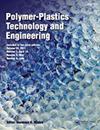Erratum to “Novel Facial Conducting Polyamide-Based Dithiophenylidene Cyclyhexanone Moiety Utilized for Selective Cu2+ Sensing”
Q2 Materials Science
引用次数: 5
Abstract
ABSTRACT The present work is aimed to synthesize a novel series of linear polyamides (PAs) 4a–d based on di(thiazolyl-thiophenylidene)cyclyhexanone as well as carries aliphatic and aromatic species in the polymer main backbones. The polymerization process was occurred by solution polycondensation technique by the interaction of the newly synthesized monomer 3 with adepoyl, sebacoyl, terphthaloyl, and isophthaloyldiacid chlorides. Before polymerization, the structure of monomer 3 was confirmed by elemental and spectral analyses. The structures of polymers were also investigated by elemental, spectral analysis, thermal analysis, and Field-Emission Scanning Electron Microscopy (FE-SEM) micrographs. Film draw temperatures for all the polymers were evaluated in the range 509.0–542.3°C. Here, the heavy metallic sensors are developed with the polyamide-fabricated glassy carbon electrode (GCE) by reliable current vs. voltage technique. A thin layer of PA onto GCE was fabricated with conducting coating agents (5% nafion) to fabricate a selective heavy metal ions, Cu2+ sensor in short response time in phosphate buffer phase. The fabricated sensor was also exhibited higher sensitivity, lower detection limit, large dynamic concentration ranges, long-term stability, and improved electrochemical performances toward Cu2+ sensor. The calibration plot is linear (r2: 0.9956) over the large Cu2+ ion concentration ranges (1.0 nM to 10.0 mM). The sensitivity and detection limit is 3.4177 µA cm−2 µM−1 and 0.36 nM (signal-to-noise ratio of 3) respectively. This novel effort is initiated a well-organized way of efficient cationic sensor improvement with conductive polymers for heavy metallic pollutants in environmental and health-care fields in large scales. GRAPHICAL ABSTRACT“基于聚酰胺的新型面部导电二噻吩基环己酮片段用于选择性Cu2+传感”的勘误
摘要本研究以二(噻唑基-噻吩基)环己酮为主要骨架,以脂肪族和芳香族为主要骨架,合成了一系列新的直线型聚酰胺(PAs) 4a-d。通过溶液缩聚技术,将新合成的单体3与二甲酰、癸二酰、三苯二酰和异苯二酰氯相互作用,进行了聚合反应。聚合前对单体3的结构进行了元素分析和光谱分析。通过元素分析、光谱分析、热分析和场发射扫描电子显微镜(FE-SEM)对聚合物的结构进行了研究。所有聚合物的薄膜拉伸温度在509.0-542.3°C范围内进行评估。本文采用可靠的电流vs电压技术,利用聚酰胺制造的玻碳电极(GCE)开发了重金属传感器。采用导电涂层剂(5% nafion)在GCE表面制备了一层薄层PA,在磷酸盐缓冲相中快速响应制备了选择性重金属离子Cu2+传感器。该传感器对Cu2+具有较高的灵敏度、较低的检出限、较大的动态浓度范围、长期的稳定性和较好的电化学性能。在较大的Cu2+浓度范围内(1.0 nM ~ 10.0 mM),校正图呈线性关系(r2: 0.9956)。灵敏度为3.4177µA cm−2µM−1,检出限为0.36 nM(信噪比为3)。这种新颖的努力是在环境和卫生保健领域大规模利用导电聚合物对重金属污染物进行高效阳离子传感器改进的一种组织良好的方式。图形抽象
本文章由计算机程序翻译,如有差异,请以英文原文为准。
求助全文
约1分钟内获得全文
求助全文
来源期刊

Polymer-Plastics Technology and Engineering
工程技术-高分子科学
CiteScore
1.71
自引率
0.00%
发文量
0
审稿时长
4 months
 求助内容:
求助内容: 应助结果提醒方式:
应助结果提醒方式:


